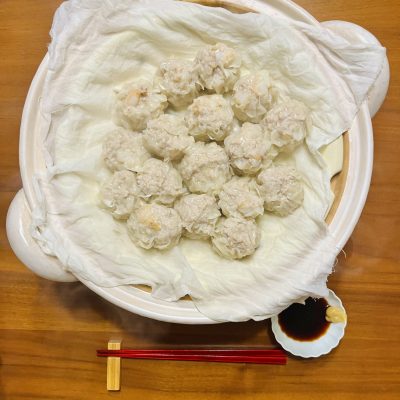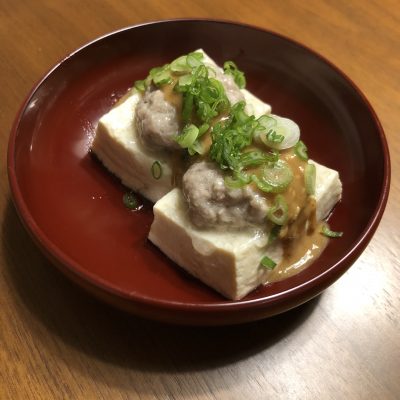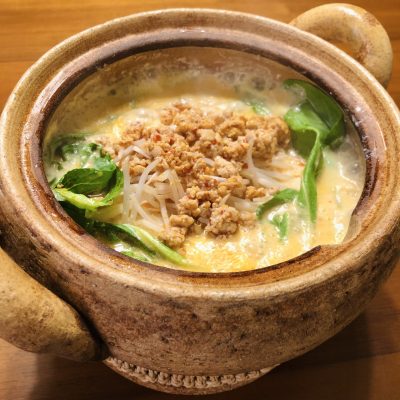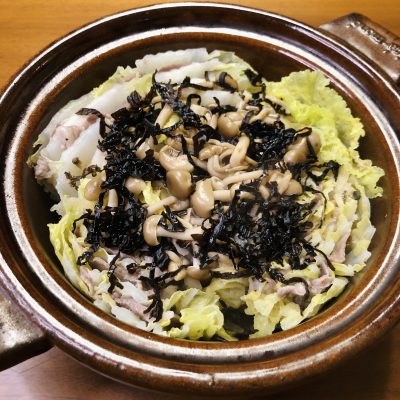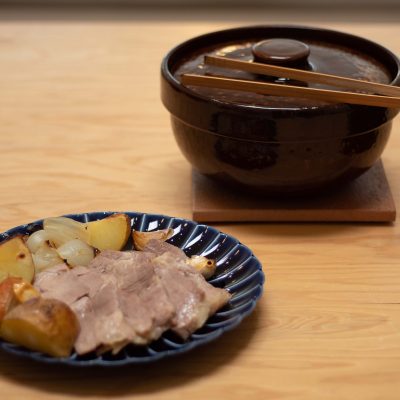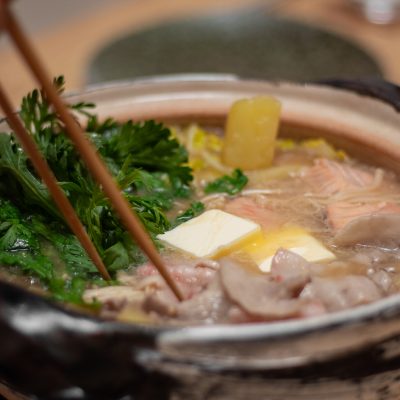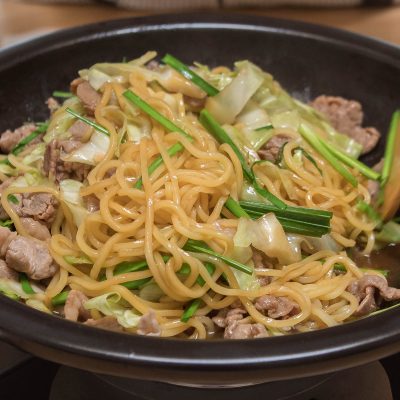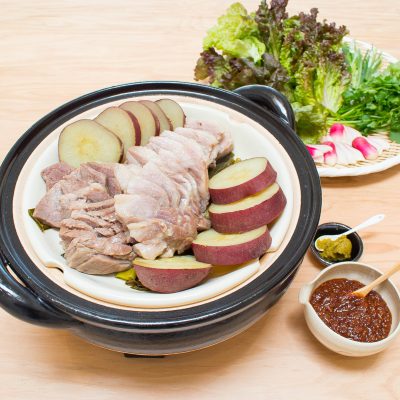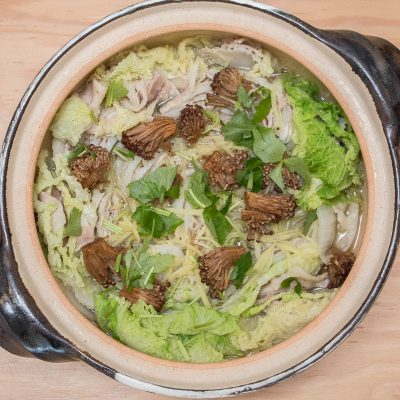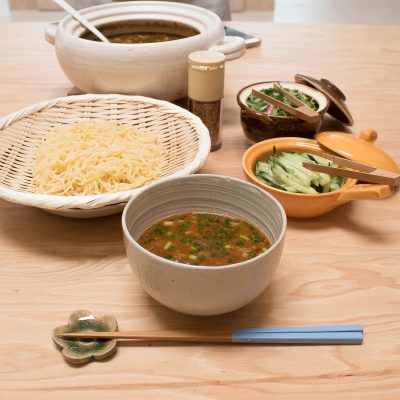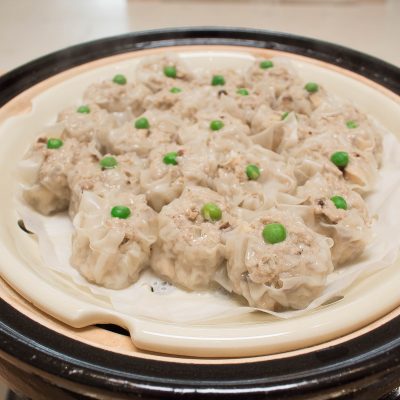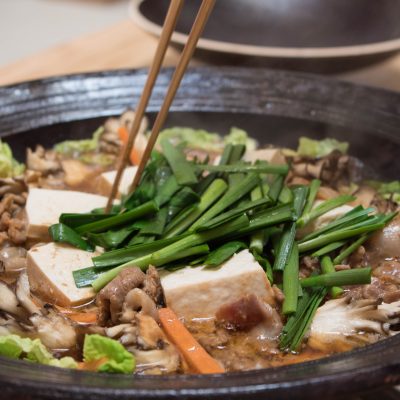This steamed donabe dish is so tasty and nourishing. The thinly-sliced pork and cabbage always make a great flavor combination. The ingredients are simply steamed in a donabe steamer, Mushi Nabe for 4 – 5 minutes and served with pre-prepared ponzu and garlic miso dipping sauces. Feel free to substitute any ingredients to steam and enjoy!
Tag Archives: Pork
Shrimp Pork Shumai
Nothing is more appetizing than the steaming hot shumai dumplings. With the donabe steamer, Mushi Nabe, you can quickly steam them and serve right out of it at a table. Feel free to change the ratio of pork and shrimp. I slice the shrimp coarsely so the finished texture is really fantastic. It’s a very irresistible dish so I can easily eat more than 10 pieces in one meal! The dipping sauce is simple combo of soy sauce and rice vinegar, plus a dab of karashi (Japanese hot mustard) adds a great kick.
Steamed Meat-Topped Tofu with Sesame Sauce
This tasty dish is a simple steamed tofu, topped with ginger-flavor ground pork. It’s easy to prepare and brings such comfort to my heart and stomach always. I like to finish with the rich sesame sauce. This sauce is also quite versatile and I like to pour over steamed vegetables, seafood, chicken, dim sum, etc. You can substitute the pork with ground chicken if you like.
Soymilk Tan Tan Nabe
Tan Tan Nabe, or Chinese-inspired miso-sesame broth with ground meat donabe hot pot is one of the most popular dishes from my DONABE Cookbook. Here is another variation of Tan Tan Nabe and it’s Soymilk Tan Tan Nabe. The soymilk adds the extra richness to the flavor of this dish, while the dish is quite healthy. The broth is so flavorful and soothing with a spicy kick. Also, it’s so easy to make. So, I love making this dish so much.
Shio-Kombu Pork & Napa Cabbage Mille Feuille
This is such a simple dish as all I need to do is to pile up napa cabbage and pork slices (this time, I used pork shoulder, but pork belly is also good), cut them and stuff in a donabe . The seasoning is basically just the Shio-Kombu, and it releases so much umami flavors to the dish! The donabe cooks the ingredients evenly in just 15 – 20 minutes over stovetop, and you don’t need to do anything to it, meanwhile. Both the napa cabbage and pork become so tender!
The dish is already so tasty on its own, but I like to drizzle a small amount of ponzu or a dab of yuzu-kosho.
Roasted Salt-Marinated Pork
This is a basic, and also my favorite recipe using Roast Donabe. This extra-durable donabe is thick-bodied with a sturdy flat lid which can tight seal. And, it’s quite handy. You can simply set your choice of ingredients on the roast grate, and set the donabe (with the lid on) over gas stove to roast. The cooking time can vary depending on the type of ingredients, and it’s easily adjustable. By lining the bottom with a piece of aluminum foil (although it’s optional), it can catch all the drippings from ingredients during cooking and make the cleaning very after use.
This donabe is also great for slow cooking such as stew, braising, or oven roasting. I love this donabe so much, because with such a minimum work, I can make the really amazing roasted pork etc. and can also make my guests excited.
Miso Butter Hot Pot with Salmon and Pork
I’ve made this hot pot many times this season, both for myself and many other people. And, many of them asked me to share the recipe so they can make it home. The miso broth has two kinds of miso for complexity. The addition of butter at the end gives the beautiful depth in flavor.
Ishikari Nabe is originally a regional dish from Hokkaido (the northern island of Japan), and to me, the must “rule” to be called Ishikari Nabe is that the dish has to have salmon and potato in the miso broth. They taste so good together (especially with the butter added at the end)! That being said, the broth can go well with just about anything, so you can change around the ingredients to cook in it. When I cook for my vegan friends, I use kombu and shiitake dashi, and make it with tofu and different kinds of mushrooms (and no butter).
You can make the miso base (mixture of the miso, sake, mirin and soy sauce) in advance, and when it’s ready to serve, you can simply combine the miso base with dashi, and start cooking the ingredients in it at the table (or at in the kitchen stove and serve at the table).
For “shime” (finishing course), I love making ojiya (soupy porridge) in the remaining broth. Ramen is also great, too.
Oyster Sauce Flavored Steam-Fry Pork Yakisoba Noodle
Yakisoba (stir-fry noodles) is such a casual tasty dish which almost everybody in Japan loves. While there are so many variations of yakisoba, my all time favorite is the simple oyster sauce flavor with pork and cabbage. This yakisoba makes me feel nostalgic, as it’s similar to what my mom used to make for a quick lunch when I was a child. With the tagine-style donabe, Fukkura-san, the ingredients are steam-fried and the noodles have such a nice bouncy texture, while the meat and cabbage get lightly caramelized. Instead of typical karashi (Japanese hot mustard), I like serving this dish with Kanzuri.
As a variation, you can substitute soy sauce with Smoked Soy Sauce for a nice smokey and robust nuance.
Steamed Moshio-Salt-Marinated Pork Shoulder
This dish was inspired by a popular Korean dish, bossam, which I love. In bossam, boiled pork belly block is sliced and served with condiments, and you can make a wrap with a napa cabbage leaf. In my version, I start with a pork shoulder block and marinade it with Moshio (seaweed sea salt) for overnight to a full day. If you don’t have moshio, you can use other kind sea salt, but moshio really makes the flavor so rich and complex, and also tenderize the meat very well. The meat is, then, steamed in donabe, and sliced to serve with lettuce leaves and condiments. You can make it with pork belly, too.
This dish is so simple to make and is also real fun dish to share at a table. All you have to do for cooking is simply put a block of salt-marinated pork shoulder in the Mushi Nabe, and steam for about 30 minutes or until done. When you are entertaining guests, you can pre-cook the meat in advance, and just reheat in the donabe before service. If you slice the meat in front of the guests, it will bring out more excitement. Then, at the table, you can have lettuce and condiments ready, and everybody can make his/ her own wraps. The meat is so tender and flavorful, and it’s pretty hard to stop eating once you start.
Pork and Napa Cabbage Mille Feuille
This dish is all about pork and napa cabbage, cooked in a minimum way. They are simply layered to pack in a donabe, with a small amount of water and sake. There is not even dashi or salt. You can top them with some sliced ginger and mushrooms, and gently simmer for 25 – 30 minutes. The result is a tasty treat rich in umami, and it looks beautiful, too. The soup is also packed with all the natural flavors from the ingredients, so make sure to enjoy it with the dish, too.
I like to serve it with Sansho Ponzu Sauce and Hatcho Miso & Black Sesame Sauce (recipe below) for flavor variations. Or, you can simply serve it with yuzu-kosho or Kanzuri, too.
Mabo Tofu
This is a Japanese version of popular Chinese dish (mapo tofu), which is a spicy stew of tofu and ground pork. My Mabo Tofu is seasoned with miso, and it gives nice rich flavor to the dish. For the spicy heat and extra umami, tobanjan (Chinese chili bean paste) is usually an essential ingredient for this dish. But, I often substitute it with Kanzuri, and it works great, too! You can make this dish with any classic-style donabe, or Mushi Nabe without the steam grate. I used my Bistro Mushi Nabe in the photos in this recipe.
Cold Ramen with Spicy Pork & Sesame Dipping Broth
Cold ramen noodles with simmering hot and spicy broth with toppings create a wonderful dish to enjoy in the summer or all year round. The dipping broth is especially rich as it’s seasoned with hatcho miso (very dark miso made of 100% soybeans) with tamari soy sauce. But, if you don’t have either, you can simply substitute with quality red miso and dark soy sauce respectively and it would still be very tasty. You can also serve the broth cold, and it will be so refreshing and perfect to enjoy on a hot day.
Pork Keema Curry
I’ve been making this dish for years and I receive requests to make it over and over from my family and friends. There are a few “secret” ingredients to make this dish taste so delicious although it’s a simple recipe. They are ketchup, Japanese black vinegar, and Japanese fish sauce. This curry is perfect with donabe Turmeric Rice and eggs (they are both cooked in Kamado-san at the same time), or plain rice.
Pork Shumai Dumplings
Simple pork shumai dumplings are so easy to make and taste so good that I always have hard time stop eating. The meat becomes so juicy, and with the dipping sauce (combination of soy sauce and rice vinegar) and a little dab of karashi (Japanese mustard), the flavors explode in the mouth. You can make the filling a few hours in advance, and just wrap in wonton skins right before steaming, so the wontons won’t get too wet and sticky. Very thin wontons skins are my choice and they are normally available at Japanese markets. Karashi is very hot, so if you are not familiar with it, try a tiny amount first to see how much you can handle.
Spicy Pork Sesame Hot Pot
The marinade has such a rich flavor, and the creamy sesame paste makes it so aromatic. Once you have all the ingredients ready, all you need to do is just piling up the ingredients and build your excitement while waiting for the dish to cook. I love that I can taste so many different ingredients in this one dish, but you can always substitute or omit most of the ingredients as you like.
Steamed Pork Belly Shabu Shabu
It takes very little time for prepping and you can make such a satisfying complete one pot dish. If you can’t find thinly-sliced pork belly from a market, you can just buy a block and slice it into thin pieces. For a leaner choice, pork loin is also good. I like to marinade the meat in Liquid Shio-Koji for a short time because it further tenderize the meat and enhances the flavor. But, you can omit this process and the dish will still taste great. If you are cooking for a larger group, increase the recipe amount and cook multiple batches at the table!


